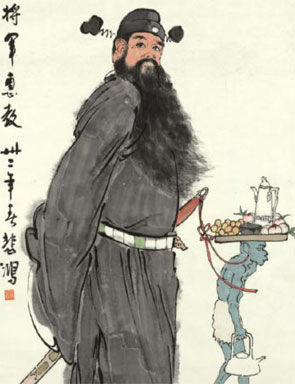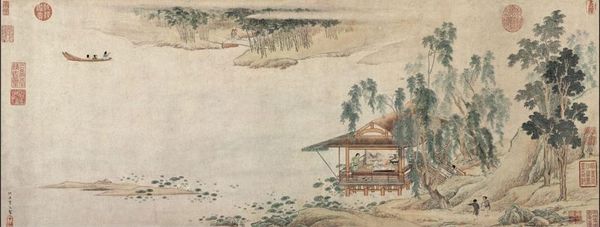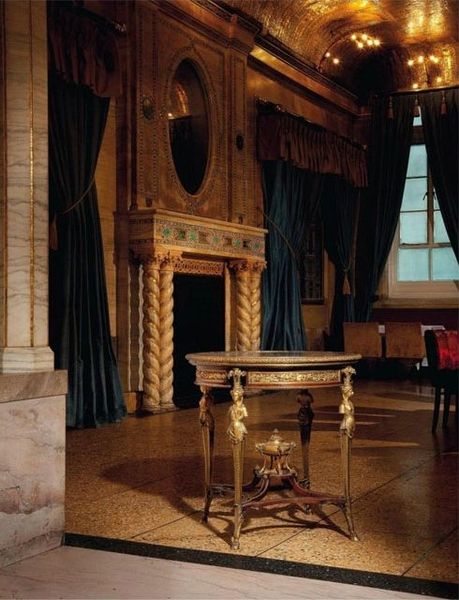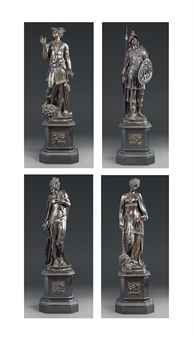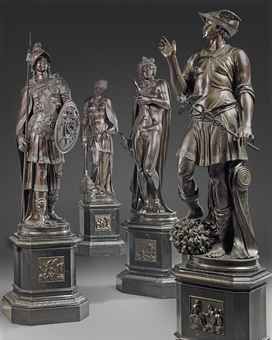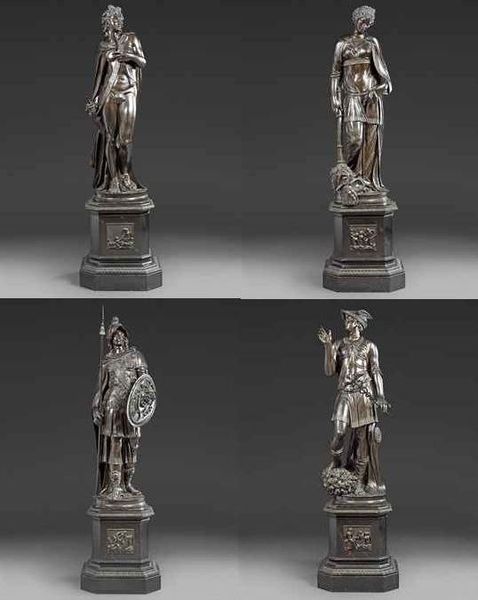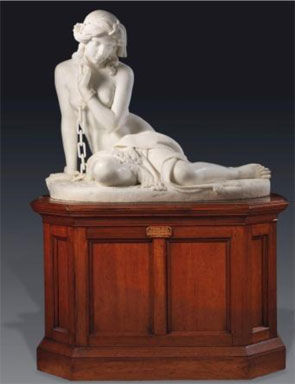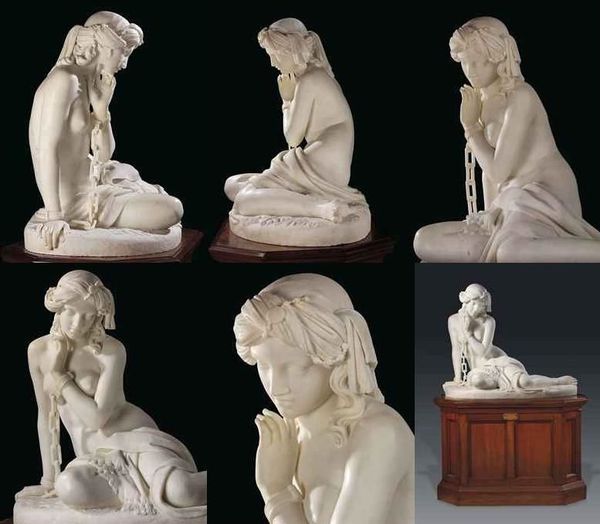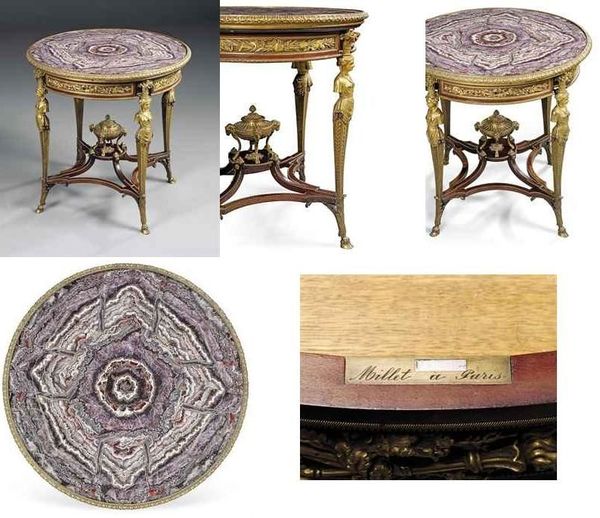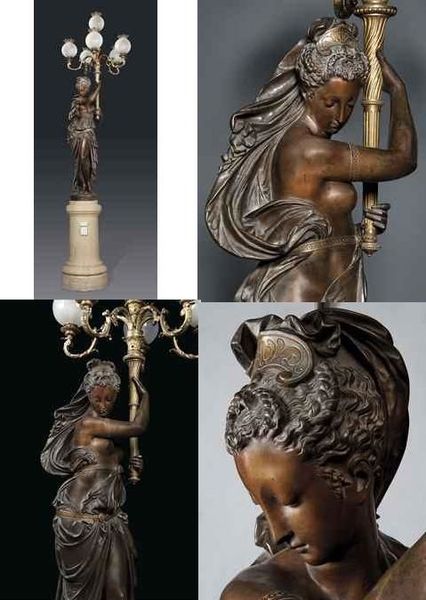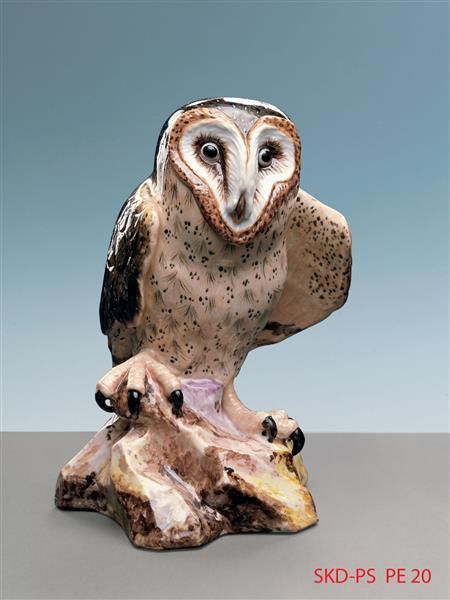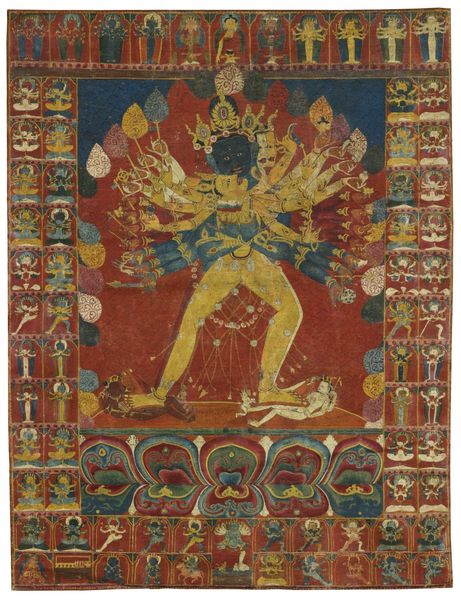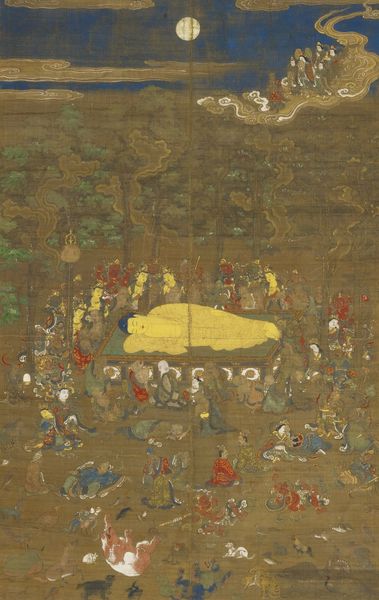Xu Beihong (1895-1953), Zhong Kui. Scroll, mounted for framing, ink and color on paper, 51 ½ x 27 in. Estimate: $180,000-250,000. Photo: Christie's Images Ltd 2013.
New York - On 18 September, Christie’s will present the sale of Fine Chinese Paintings,which will encompass over 160 works, with traditional paintings and calligraphy ranging from the Ming dynasty to the modern period and representing a wide variety of themes and styles. Highlights include paintings and calligraphy by such classical masters as Shen Zhou, Dong Qichang, and Chen Chun, as well as modern works by such popular figures as Qi Baishi, Zhang Daqian, and Xu Beihong.
 Painters of the Wu School in Suzhou during the Ming dynasty (1368-1644) created some of the most erudite, yet expressive works in Chinese paintings history. Several important paintings in the sale embody the sophistication and elegance of the Wu School. Important paintings in this selection include Mountains in Autumn, a landscape painting by Shen Zhou (1427-1509). Scroll, mounted and framed, ink and color on paper. Inscribed and signed by the artist, dated xinchou year of the Chenghua era (1481). Second inscription by the artist in which he commented:
Painters of the Wu School in Suzhou during the Ming dynasty (1368-1644) created some of the most erudite, yet expressive works in Chinese paintings history. Several important paintings in the sale embody the sophistication and elegance of the Wu School. Important paintings in this selection include Mountains in Autumn, a landscape painting by Shen Zhou (1427-1509). Scroll, mounted and framed, ink and color on paper. Inscribed and signed by the artist, dated xinchou year of the Chenghua era (1481). Second inscription by the artist in which he commented:
It has been two decades since I first painted this. Twenty-two years have passed like a day. I do not recall for whom I painted this [picture]. My hair and teeth have fallen out; I no longer look young and happy like before. Everything is in decline. Someone bought back this painting on the market. As it cannot be sold for 700 wen, I returned it to him, with lamentations on how things wax and wane, and that life is so short.
Second inscription dated renxu year of the Hongzhi era (1502), at the age of 76 sui. One seal of the artist.Two collector's seals of Ding Nianxian (1906-1969). One illegible collector's seal; 58 x 22 5/8 in. (147.5 x 57 cm.) (lot 904, estimate: $230,000-330,000). Photo Christie's Image Ltd 2013 (right). This painting comes from The Family of C.C. Wang, where it has remained in his family for several decades. A fellow native of Suzhou, C.C. Wang acquired this painting by Shen Zhou in Hong Kong, and it has remained in his family for several decades. aHe gifted it to his eldest daughter, who is a painter, so that she could study it to understand and master Shen Zhou's style. In keeping with tradition, C.C. Wang emphasized the importance of brushwork and learned and taught by copying the works of ancient masters. The brushwork, as well as the composition and mood, in this painting typifies Shen Zhou's characteristic style of the period and compares well with Walking with a Staff, created around 1485, in the National Palace Museum in Taipei.. C.C. Wang (1907-2003) was an active artist, art teacher, and collector. He learned traditional Chinese painting techniques as a youth in China, but explored new ideas and styles when he arrived in New York.
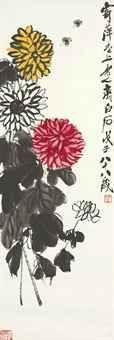 Maintaining, yet modernizing the tradition, are works by such modern masters as Qi Baishi (1863-1957) and Xu Beihong (1895-1953). Both artists used traditional materials to depict well-known themes for their paintings such as Qi Baishi’s Chrysanthemum and Bees. Hanging scroll, ink and color on paper. Inscribed and signed by the artist, with two seals. Dated wuzi year (1948);39¾ x 13¾ in. (101 x 33.5 cm.) (lot 1030, estimate: $90,000-120,000) Photo Christie's Image Ltd 2013 (left). Qi Baishi captures the vibrancy of the chrysanthemum blossoms with his rapid and sure brushstokes, and his finely detailed strokes of the buzzing bees reveal his exceptional skill.
Maintaining, yet modernizing the tradition, are works by such modern masters as Qi Baishi (1863-1957) and Xu Beihong (1895-1953). Both artists used traditional materials to depict well-known themes for their paintings such as Qi Baishi’s Chrysanthemum and Bees. Hanging scroll, ink and color on paper. Inscribed and signed by the artist, with two seals. Dated wuzi year (1948);39¾ x 13¾ in. (101 x 33.5 cm.) (lot 1030, estimate: $90,000-120,000) Photo Christie's Image Ltd 2013 (left). Qi Baishi captures the vibrancy of the chrysanthemum blossoms with his rapid and sure brushstokes, and his finely detailed strokes of the buzzing bees reveal his exceptional skill.
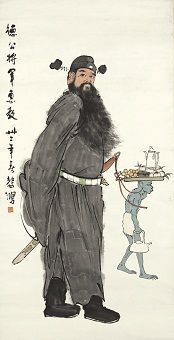 Xu Beihong’s Zhong Kui. Scroll, mounted for framing, ink and color on paper
Xu Beihong’s Zhong Kui. Scroll, mounted for framing, ink and color on paper
Inscribed and signed by the artist, with one seal. Dedicated to General Degong (General Li Zongren, 1890-1969). Dated spring,the thirty-second year [of the Republic] (1943). 51½ x 27 in. (130.8 x 68.8 cm.) (lot 1008, estimate: $180,000-250,000) Photo Christie's Image Ltd 2013 (right) illustrates a powerful-looking image of Zhong Kui, the demon-queller, in contrast with the stooped and skinny blue demon who is comically reduced to carrying Zhong Kui’s snack on his head.
This painting is dedicated to General Li Zongren (1890-1969), one of the most famous and successful generals in 20th century China. A native of a village near Guilin, he served as Military Governor of Guangxi from 1924 to 1925 and continued to influence the region until 1949. He played an important role in the Northern Expedition and held numerous key military posts. His success in the Battle of Taierzhuang in 1939 marked the first time that Chinese forces were able to defeat the Japanese during the Second Sino-Japanese War. In the 1940s General Li moved to the United States for medical treatment and remained until 1965. Then, with the support of Premier Zhou Enlai, he returned to China with great fanfare and eventually passed away in Beijing in 1969.
This painting is reported to have been given by General Li to a close associate who immigrated to the United States with him.
From the Ping Y. Tai Foundation is Lotus Picking, attributed to Qiu Ying (1495-1552). Handscroll, ink and color on paper. Signed by the artist. One seal of the artist. Two colophons, one by Yu Yunwen (1512-1579), dated first year of the Longqing era (1567) and with three seals and one by Zhang Fengyi (1527 - 1613), with two seals.Title slip by Zhang Daqian (1899-1983), signed with two seals, dated bingxu year (1946). Twenty-four collector's seals, including one of Zhang Chou (1577- 1643), nine of An Qi (1683-after 1742), six of Hong Li (Emperor Qianlong, 1771-1799, reigned 1736-1796) and eight others; 14¼ x 37½ in. (36.3 x 95.3 cm.) (lot 905, estimate: $300,000-500,000). Photo Christie's Image Ltd 2013 (below). This handscroll features a scholar at leisure, however, the true theme of this painting is the activity of the women. Ping Y. Tai (1915-1998) was the wife of the legendary connoisseur, collector, and dealer Jun Tsei Tai (1911-1992), fondly known in international art circles as J.T. Tai. These Chinese paintings were acquired by Mr. and Mrs. Tai were kept at home for their personal enjoyment.
From the Ping Y. Tai Foundation is Lotus Picking, attributed to Qiu Ying (1495-1552) (pictured above, lot 905, estimate: $300,000-500,000). This handscroll features a scholar at leisure, however, the true theme of this painting is the activity of the women. Ping Y. Tai (1915-1998) was the wife of the legendary connoisseur, collector, and dealer Jun Tsei Tai (1911-1992), fondly known in international art circles as J.T. Tai. Photo: Christie's Images Ltd 2013.
Ping Y. Tai (1915-1998) was the wife of the legendary connoisseur, collector, and dealer Jun Tsei Tai (1911-1992), fondly known in international art circles as J.T. Tai. These Chinese paintings were acquired by Mr. and Mrs. Tai without commercial intent and were kept at home for their personal enjoyment.
Mrs. Tai was born Chang Ping Ying in Suzhou in 1915. In 1932 in Shanghai, she married Jun Tsei Tai, who was already a highly respected connoisseur and dealer of Chinese ceramics, ancient bronze vessels and carved jades. Like many of their compatriots, Mr. and Mrs. Tai moved to Hong Kong in 1949, a year of great political and social upheaval in China. In 1950 Mr. Tai settled in New York and was joined by Mrs. Tai in 1953. Working first with the leading Paris-based dealer C.T. Loo, Mr. Tai soon established his own gallery, J.T. Tai and Co., on Madison Avenue in New York City's elite district of museums and galleries. Many masterpieces in major American museums and collections, such as the Metropolitan Museum of Art, the Freer Gallery of Art, the Avery Brundage collection and the Arthur M. Sackler collections were acquired from Mr. Tai. In this way, he was a primary force that profoundly influenced the appreciation of Chinese art in America and Europe.
Ping Y. and J.T. Tai were a central part of the cultural elite in New York's Chinese community, which included such renowned artistic and literary figures as C.C. Wang, Lin Yutang, Wan-go Weng, and Wang Fang-yu. In the time-honored tradition of Chinese collectors, they would study and enjoy each painting or object during private moment together or at gatherings with their connoisseur friends. In addition to good food and art, there were also frequent mah-jong games and Mrs. Tai was an especially enthusiastic participant.
Literature: Zhang Chou (1577-1643), Zhenji Renlu (Catalog of Genuine Works), see Zhong Guo Shu Hua Quan Shu(Collection of Chinese Paintings and Calligraphy), vol. IV, Shanghai Publication House, 1992, p.412
Wu Sheng (18th century), Da Guan Lu (General Catalog of Paintings), see Zhong Guo Shu Hua Quan Shu(Collection of Chinese Paintings and Calligraphy), vol. VIII, Shanghai Publication House, 1994, p.579 - 580
An Qi (1683-after 1742), Moyuan Hui Guan (A Compendium of Ink Paintings), see Zhong Guo Shu Hua Quan Shu (Collection of Chinese Paintings and Calligraphy), vol. X, Shanghai Publication House, 1996, p.416
Siren, Osvald, Chinese Painting: Leading Master and Principles, London, 1956-1958, vol. VII, p.174.
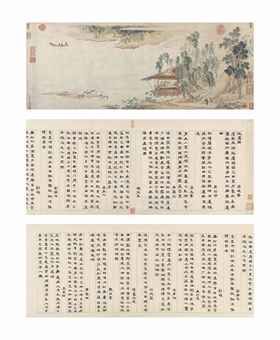 Notes: This short handscroll features a scholar at leisure reclining with his robes open and his legs crossed in an open waterside pavilion. The true theme of this painting, however, is the activity of the women-the servant next to the scholar who holds a long pole and the three ladies in the small boat-who are all engaged in picking lotus seeds. As reflected in the transcriptions of ancient poems in this scroll's colophons, this task was conducted in the summer to gather the ingredients to make a cooling soup and has long been celebrated in literature as a topic associated with women, beauty and romance.
Notes: This short handscroll features a scholar at leisure reclining with his robes open and his legs crossed in an open waterside pavilion. The true theme of this painting, however, is the activity of the women-the servant next to the scholar who holds a long pole and the three ladies in the small boat-who are all engaged in picking lotus seeds. As reflected in the transcriptions of ancient poems in this scroll's colophons, this task was conducted in the summer to gather the ingredients to make a cooling soup and has long been celebrated in literature as a topic associated with women, beauty and romance.
Lotus Picking is followed by two colophons. Yu Yuwen (14th century) first copied in clerical script (li shu) two famous poems, primarily from the Liang and Tang dynasties, on the painting's theme. He then discussed the history of this subject, praised Qiu Ying for successfully capturing an "ancient feeling" (gu yi) and related that this painting was made for the high-ranking official Zhou Yuhuang, who then asked Yu to write out these ancient poems. The second colophon was written by Zhang Fengyi (1550-1636) and is a transcription of the Tang poet Wang Bo's (649-676) famous poem on this subject Cailian Qu.
